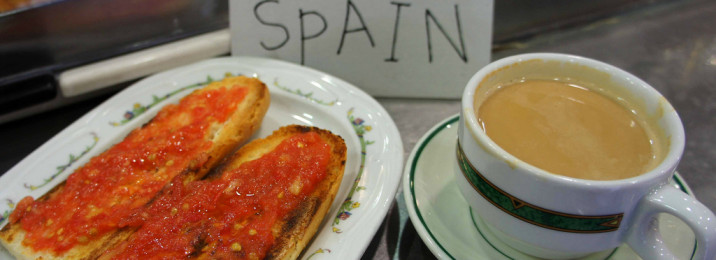Desayuno: A Typical Spanish Breakfast
Literally translated, the Spanish word for the first meal of the day – desayuno – has the same meaning as the English (des- being a prefix meaning ‘not’, similar to the English ‘dis-‘, and ayuno referring to a fast) but the similarities largely end there.
The Spanish breakfast is typically very small, especially by comparison to American standards, and this fact has led many outsiders to assume that as a meal, desayuno lacks importance. But while Spanish breakfasts might be less formalised and sociable than other meals of the day, the regional and stylistic variety of foods, which seem to cater for everybody’s taste, are an indication that desayuno is universally enjoyed.
Broadly speaking, desayuno is breakfast in the proper sense of the word – a small snack intended to wake up the metabolism without overwhelming the body. One classic option is the Catalan pan con tomate, consisting of thick toast (tostada) topped with ripe tomatoes, extra virgin olive oil, garlic (sometimes), salt, and cracked black pepper. An alternative topping is sobrasada (a kind of chorizo paté from Mallorca), and meat and cheese are sometimes added for brunch or as part of a larger lunch, but as a breakfast food simplicity is key. Tostada is often also eaten smeared with mantequilla (butter) or orange, strawberry, apricot or quince jams from fruit-growing regions like Murcia, Valencia, and La Rioja.
Actually, the Spanish breakfast is well-suited to those with a sweet tooth. Magdalenas (or madalenas) are just one of many styles of breakfast cake. Made with flour, eggs, sugar, and olive oil spiced with cloves and lemon or orange zest, these can be light and fluffy like sponge cakes, or heavier like pound cake. Magdalenas are thought to have originated in Aragon, and there are plenty more breakfast cakes from other regions across Spain. Bica Gallega, for instance, is a rich Galician sponge made with clarified butter and a sugary crust, tortas de aceite are light olive oil cakes from Andalucia, and quesadas are goat’s cheese cakes from Asturias.
Another common breakfast is churros: long strings of fried dough with a star-shaped cross section, sprinkled with sugar and served straight from the pan with thick hot chocolate. These are often touted as a typical Spanish breakfast but really they tend to be a special treat for colder days of the year, and were supposedly invented by shepherds for whom this simple, filling, and easy-to-make food was a convenient alternative to other baked pastries. In fact, the name may derive from the churra breed of sheep, the horns of which resemble churros.
Desayuno is often eaten out at a bar and there will almost always be some freshly-squeezed zumo de naranja (orange juice) on offer. Coffee is another a staple of the Spanish breakfast, and is probably more important than the food. Widely available throughout Spain and Spanish history, coffee was originally sourced from Turkish traders, Portuguese colonies in Africa, and ex-patriot growers in Latin America. No surprise, then, that it underpins the average Spanish day. From breakfast right through until after dinner at around ten or eleven pm, coffee is drunk hot, cold, with milk, without milk, with cream or brandy or rum, and the Spanish idea of a coffee house is far more sophisticated than most other countries.
The most popular breakfast coffee is the café con leche (an espresso with milk), generally preferred as a less strong start to the day, however café solo (black espresso) and café cortada (espresso with just a dash of milk, similar to the Italian macchiato) are also common. Manchada (piping hot milk with a little coffee, like a latte) is equally popular in the south – especially Andalusia, where it is called a café sombra.
Essentially, breakfast is the least organised and most personal meal of an otherwise very regimented day. It’s followed by la merienda at around eleven o’clock (typically a stronger coffee and a cheese or ham bocadillo) as a kind of second breakfast when the body is better able to digest large quantities of food. Despite its small size and informality, however, the Spanish breakfast is somehow very special – and never to be missed.
If you haven’t tried our Spanish breakfast/brunch it is definitely something to add to you Sunday to do list. We only serve brunch on Sunday and it’s just like going to grandma’s house. Come and try our scrumptious dishes. Check out our menu and add us to your calendar; we are open for brunch only on Sunday’s 10:00am - 2:00pm.


1 comment
What a wonderfully written, synoptic essay on the ways and whys of the Spanish breakfast! Thank you!